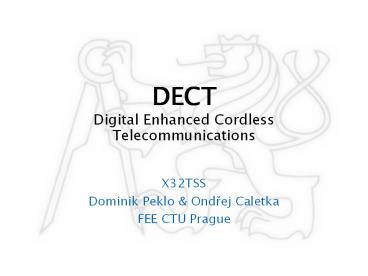DECT Digital Enhanced Cordless Telecommunications PowerPoint PPT Presentation
Title: DECT Digital Enhanced Cordless Telecommunications
1
DECTDigital Enhanced Cordless Telecommunications
- X32TSS
- Dominik Peklo Ondrej Caletka
- FEE CTU Prague
2
Introduction
- European standard for digital cordless telephony
data transmission - Picocelluar infrastructure, low power, low
interference, high capacity - Easy to deploy no need for frequency planning
- Provides cordless access to various fixed or
mobile networks via gateways
3
History
- Early 1980s saw introduction of the first analog
cordless telephone systems CT0/CT1 (mainly
Sweden, UK)? - Soon after, an inevitable shift to digital
transmission followed. CT2 coexistence standard
published in 1987 in UK - Sweden pushing its TDMA/TDD in contrast to UKs
FDMA/TDD - 1988 DECT development initiated by ETSI based
on TDMA/TDD/MC principles - 1992 DECT is approved standard ETS300-175
4
Specifications
- Modulation scheme GMSK
- Access method TDMA/TDD/MC
- Frequency band 1880-1900 MHz
- 10 carriers with 1728kHz span
- 24 timeslots per carrier (12 duplex)?
- total of 1152 Kbps per carrier
- maximum/mean Tx power 250/10 mW
- 32 Kbps ADPCM G.726 speech encoding
5
Continuous DynamicChannel Selection
- DECT portable parts continuosly measure RSSI for
all carrier and timeslot combinations and
maintain an updated list in memory - When setting up a call, the frequency/timeslot
with the lowest measured RSSI is automatically
selected
6
Handover
- Support for seamless intracell or intercell
handover as a means to escape from interfered
channel and to support endpoint mobility - Handover managed by the portable part based on
the continuous RSSI measurement of available
channels
7
Security
- Subscription registering the portable to the
network - Authentication verifying portable's key
- Ciphering Encryption of audio data by per-call
random key.
8
Application Profiles
- GAP (Generic Access Profile) Basic telephony
service, minimum set of mandatory features,
insures mutual compatibility of different
manufacturers equipment - GIP (DECT/GSM Interworking Profile) Allows DECT
portables to access GSM network DECT base
station is directly connected to GSM MSC. - IIP (ISDN Interworking Profile) DECT-based
wireless bridge for ISDN S0 interface. Effective
radio channel utilization. - RAP (Radio Local Loop Access Profile) An
alternative to laying cables on Last Mile. Cost
efficient way to spread POTS in developing
countries.
9
Advantages/Disadvanatges
- No frequency planning needed
- Low transmitted power, low interference
- Easy to use, hard to eavesdrop (ciphering)
- Cordless access to other services (VoIP etc.)
- Speech quality comparable to ISDN
- Small area coverage
- High infrastructure cost
- Need to carry 2 phones (GSM DECT)?
- Low bandwidth for data (overtaken by 802.11)
10
Conclusion
- The leading cordless telephony standard nowadays
- Encrypted for high security
- High quality speech
- Data transfer is possible
- Interference avoidance
- Being obsoleted by GSM boom
11
Time for your questions...
- References
- http//en.wikipedia.org/wiki/DECT
- http//www.dectweb.com/
- http//www.dect.ch/pdf/TechnicalDocument.PDF
- http//www.dectweb.com/LearningZone/IEEE1992Articl
e.pdf - http//www.rdc.cz/prilohy/hardware/152_DECT.pdf
- http//mobil.idnes.cz/telefony.asp?rtelefonycA9
81128_0002811_telefony

